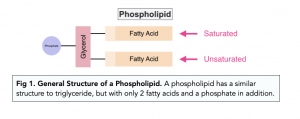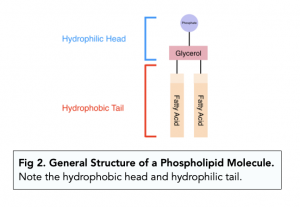Phospholipids - Introduction (A-level Biology)
Phospholipids: Introduction
Structure of Phospholipids
The second major class of biologically relevant lipids that you should familiarise yourself with are phospholipids.
- Phospholipids have one glycerol, two fatty acids and a phosphate group. These lipids are very similar to triglycerides in that they have one molecule of glycerol and two molecules of fatty acids connected to the glycerol via ester bonds. However, the third fatty acid chain is replaced by what is called a phosphate group which is covalently bonded to the glycerol.
- One of the fatty acid chains is unsaturated. Furthermore, one of the fatty acid chains is saturated, whereas the second fatty acid chain is unsaturated.

- Phospholipids are amphipathic. This means that they have both hydrophobic (repelled from water) and hydrophilic (attracted to water) regions. The fatty acid chains on a phospholipid are hydrophobic tails, and the phosphate group is referred to as the hydrophilic head.
- The phosphate groups can have extensions. The phosphate groups of different phospholipids can have additional structures attached to them, which give unique properties to unique phospholipids. To illustrate this diversity in chemical structures, we simply designate this with an “R” connected to the phosphate and call this a variable “R” group.

Phospholipids are a type of molecule that make up a large portion of the cell membrane in living organisms. They are composed of a hydrophobic (water-repelling) tail and a hydrophilic (water-attracting) head, making them ideal for forming the structure of cell membranes.
Phospholipids form the structure of cell membranes by arranging themselves in a double layer, or bilayer, with the hydrophobic tails facing inward and the hydrophilic heads facing outward. This arrangement allows the cell membrane to control the flow of substances in and out of the cell while also maintaining the integrity of the cell.
The hydrophobic and hydrophilic properties of phospholipids are significant because they allow the formation of the cell membrane bilayer. The hydrophobic tails are able to interact with each other, creating a barrier that separates the inside of the cell from the outside environment. The hydrophilic heads, on the other hand, allow for the exchange of substances between the cell and its environment, as well as for communication between cells.
Yes, phospholipids can play a role in other cellular processes, such as signal transduction and cell signaling. In these processes, the movement of phospholipids can trigger a series of events that ultimately lead to changes in cellular behavior.
Phospholipids can be altered or manipulated by adding or removing certain components, such as fatty acids or phosphates, to create new structures. These alterations can have significant effects on the properties and behavior of phospholipids, and can be used to study cellular processes and develop new treatments for diseases.
Some common examples of phospholipids in the body include lecithin, sphingomyelin, and phosphatidylcholine. These phospholipids play important roles in the function and structure of cell membranes, as well as in other cellular processes.
Phospholipids are involved in human health in many ways, including their role in the formation and function of cell membranes, their involvement in signal transduction and cell signaling, and their contribution to the structure and function of other cellular components, such as lipoproteins. Abnormalities or alterations in phospholipid metabolism can lead to various diseases and disorders, including cardiovascular disease and neurological conditions.





Still got a question? Leave a comment
Leave a comment